Der FC St. Pauli holt einen Punkt in Düsseldorf. In diesem Spiel hat erst Düsseldorf gut auf den FC St. Pauli und später der FC St. Pauli gut auf Fortuna Düsseldorf reagiert. Nach zäher erster Hälfte spielte das Team in Braun-Weiß richtig guten Fußball und ging verdient in Führung. Düsseldorf glich aber aus, mitten in die stärkste Druckphase des FCSP hinein. Nachdem das Spiel am Ende immer offener wurde, ist es wohl eine gerechte Punkteteilung. Eine nüchterne Analyse.
(Titelbild: Peter Böhmer)
Die Aufstellung
Keine Wechsel gab es beim FC St. Pauli im Vergleich zum erfolgreichen Heimspiel gegen Schalke. Ich hatte damit gerechnet, dass Finn Ole Becker starten würde und gemutmaßt, ob Jakov Medić einen der beiden Innenverteidiger ersetzen könnte. Beides war nicht der Fall, das Trainer-Team um Timo Schultz vertraute der Stammformation des letzten Spiels.
Aber ich hatte auch mit einer ganz anderen defensiven Spielweise der Düsseldorfer gerechnet. Das Team von Christian Preußer nahm nur eine Veränderung im Vergleich zum erfolgreichen Spiel gegen Darmstadt vor: Dragoș Nedelcu ersetzte den verletzten Adam Bodzek. Er rückte auf die zentrale Innenverteidiger-Position, Christoph Klarer spielte auf der rechten Seite. Fortuna Düsseldorf startete also erwartungsgemäß in einem 3-5-2. Oder etwa doch nicht?
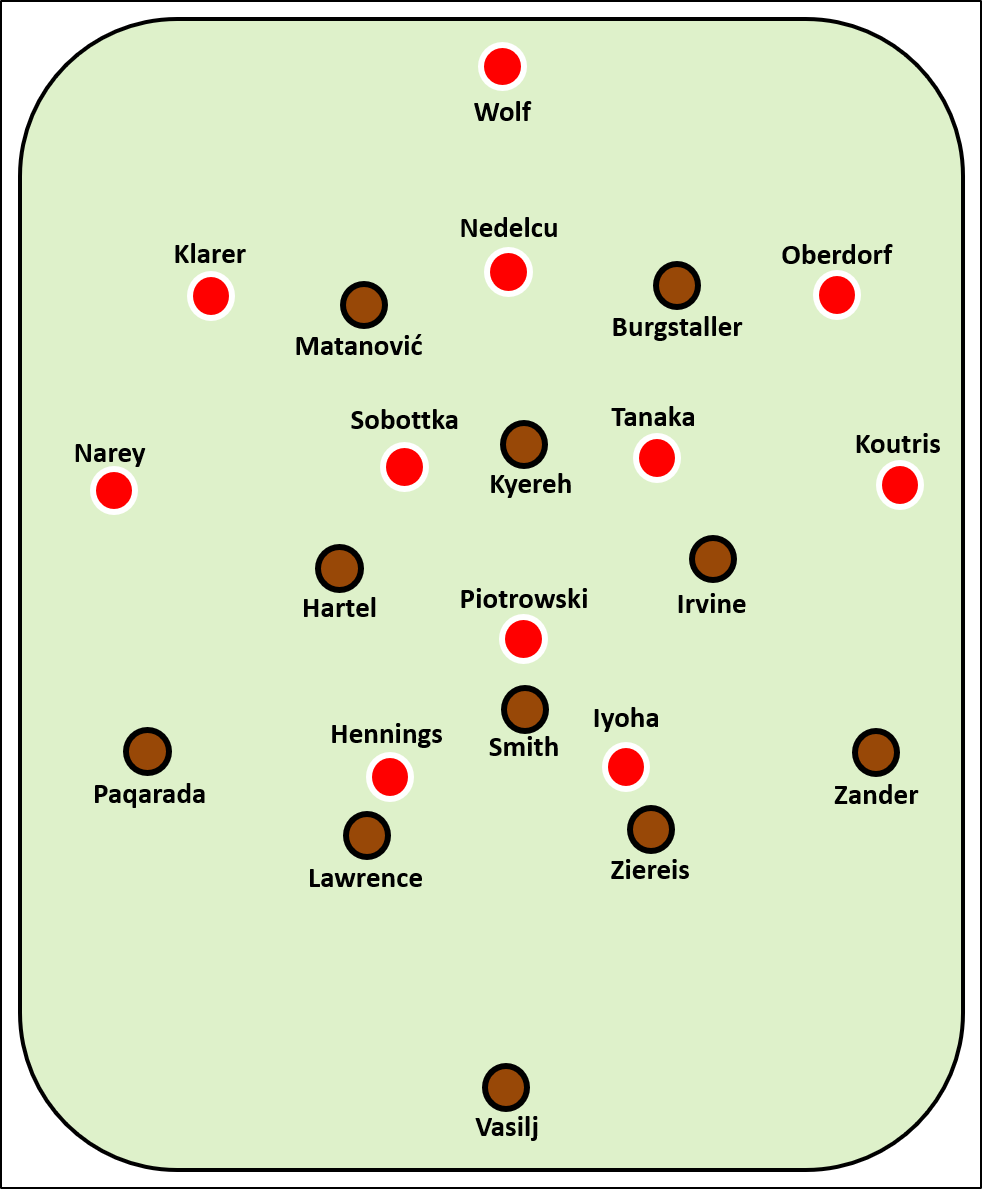
Eine Fünferkette, die nur selten eine ist
Im Vorbericht für das Spiel hatte ich beschrieben, wie Fortuna Düsseldorf ins Pressing einsteigt, in seinem 3-5-2. Ich hatte vermutet, dass diese Art des Pressing überhaupt nicht zum FC St. Pauli passt, da sie den FCSP-Außenverteidigern entweder zu viel Zeit im Spielaufbau geben oder sich die FCSP-Angreifer im Rücken der Flügelverteidiger Räume schaffen können. Daher hatte ich vermutet, dass dies zu massiven Problemen für Fortuna Düsseldorf führen würde. Ich sollte vorsichtiger mutmaßen, denn es kam anders. Denn Fortuna Düsseldorf spielte das 3-5-2 mit einer schon recht deutlichen Unwucht aus:
Khaled Narey, rechter Flügelverteidiger der Fortuna, bewegte sich bei Ballbesitz des FC St. Pauli immer ganz nah ran an Leart Paqarada. Dadurch hatte Paqarada wenig Zeit für Ballverarbeitung und -weitergabe oder wurde gar nicht erst angespielt. Es ist eine recht untypische Spielweise, dass Gegner die Außenverteidiger so eng bewachen. Diese Vorgehensweise erwies sich jedoch zu Spielbeginn als genau richtig. Der FC St. Pauli fand nicht zu seinem gefürchteten Aufbauspiel.
Durch die hohe Positionierung von Narey verschob sich die gesamte Positionierung der Düsseldorfer: Leonardo Koutris, das Pendant von Narey auf der linken Seite, interpretierte seine Rolle viel defensiver und fiel bei Ballbesitz FCSP immer in die letzte Kette zurück. Dadurch konnte die Dreierkette hinten komplett eine Position nach rechts rücken und so bildete sich aus dem nominellen 3-5-2 ein 4-4-2. Denn auch vor der hinteren Viererkette waren vier Spieler auf einer Linie, da Jakub Piotrowski aus seiner offensiven Position zwischen die Doppel-Sechs Tanaka/Sobottka fiel.
Ich würde die Formation von Fortuna Düsseldorf trotzdem weiterhin als 3-5-2 bezeichnen, da sich dieses 4-4-2 immer nur dann bildete, wenn Leart Paqarada in Ballnähe war, der Ball sich also auf der linken Seite des FC St. Pauli befand. Wenn sich der Ball nach rechts bewegte, zeigte Fortuna Düsseldorf aber keine Spiegelung des Verhaltens, sondern bildete ein klares 3-5-2.
Mit dieser Formation hatte der FC St. Pauli Probleme. Denn sie griff vieles von dem, was in den letzten Spielen für Braun-Weiß gut funktionierte, auf und störte diese Abläufe. Denn dieses partielle 4-4-2 von Düsseldorf ließ auch die breite Stellung der FCSP-Stürmer verpuffen. Gegen Schalke war genau das so etwas wie der Knackpunkt: Dem FCSP gelang es durch die Bewegung beider Stürmer nach außen, hinter die Flügelverteidiger zu gelangen, sodass die Schalker Dreierkette enorm breit ziehen musste und dadurch Räume öffnete (hier genauer erklärt). Gegen Düsseldorf versuchten es Matanović und Burgstaller anfangs ebenfalls mit diesen Bewegungen. Aber dadurch, dass Fortuna mit einer Viererkette hinten stand, konnten sie diese Bewegungen der FCSP-Stürmer problemlos aufnehmen. Ein erster Punktsieg für Düsseldorf. Das haben sie sehr gut gemacht.
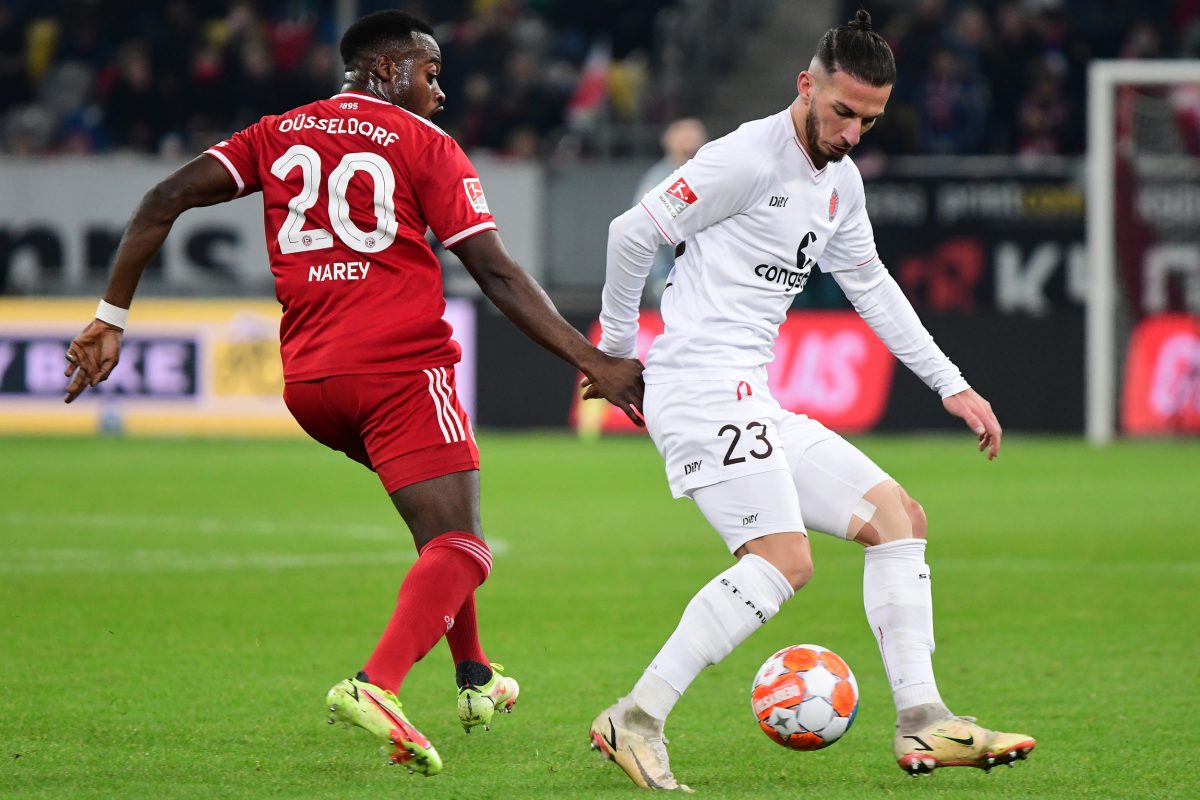
(c) Peter Böhmer
Der FC St. Pauli hingegen hat über weite Teile der ersten Halbzeit nach Lösungen gesucht. Je länger die Partie dauerte, umso häufiger wurden sie gefunden. Hierbei suchte das Team zum Ende der ersten Halbzeit immer häufiger den Aufbau über die rechte Seite, da dort der Gegnerdruck nicht direkt vom Flügelverteidiger kam, sondern Ao Tanaka aus dem Mittelfeld Luca Zander anlief, wenn dieser im Ballbesitz war. Das Aufbauspiel über rechts klappte aber nicht so richtig. Zander war anzumerken, dass er die sehr viel prominentere Rolle als Initiator der eigenen Angriffe erst einmal annehmen musste. Zusätzlich interpretiert Jackson Irvine seine Rolle auf der Halbposition immer offensiver als Marcel Hartel auf der anderen Seite, sodass sich nicht unbedingt übermäßig viele Anspielstationen für Zander bot. Zander hatte also relativ viel Raum, den er aber vor allem zu Spielbeginn nur selten nutzen konnte, da die Verlagerungen auf seine Seite meist sehr schleppend gespielt wurden.
Im Verlauf der ersten Halbzeit bewegte sich dann Marcel Hartel immer wieder auf die rechte Seite und sorgte so für eine Überzahl im Halbraum. Zudem nutzte James Lawrence mehrfach den sich ihm bietenden Raum, da mit Hennings und Iyoha nur zwei Spieler gegen Smith, Ziereis und Lawrence standen (der ballferne Angreifer agierte mannorientiert auf Smith – bei schneller Verlagerung hatten die Innenverteidiger also Raum zum Andribbeln). Auch dank dieser Bewegungen konnte der FC St. Pauli mehr und mehr Spielkontrolle erlangen und war zum Ende der ersten Halbzeit das klar bessere Team.
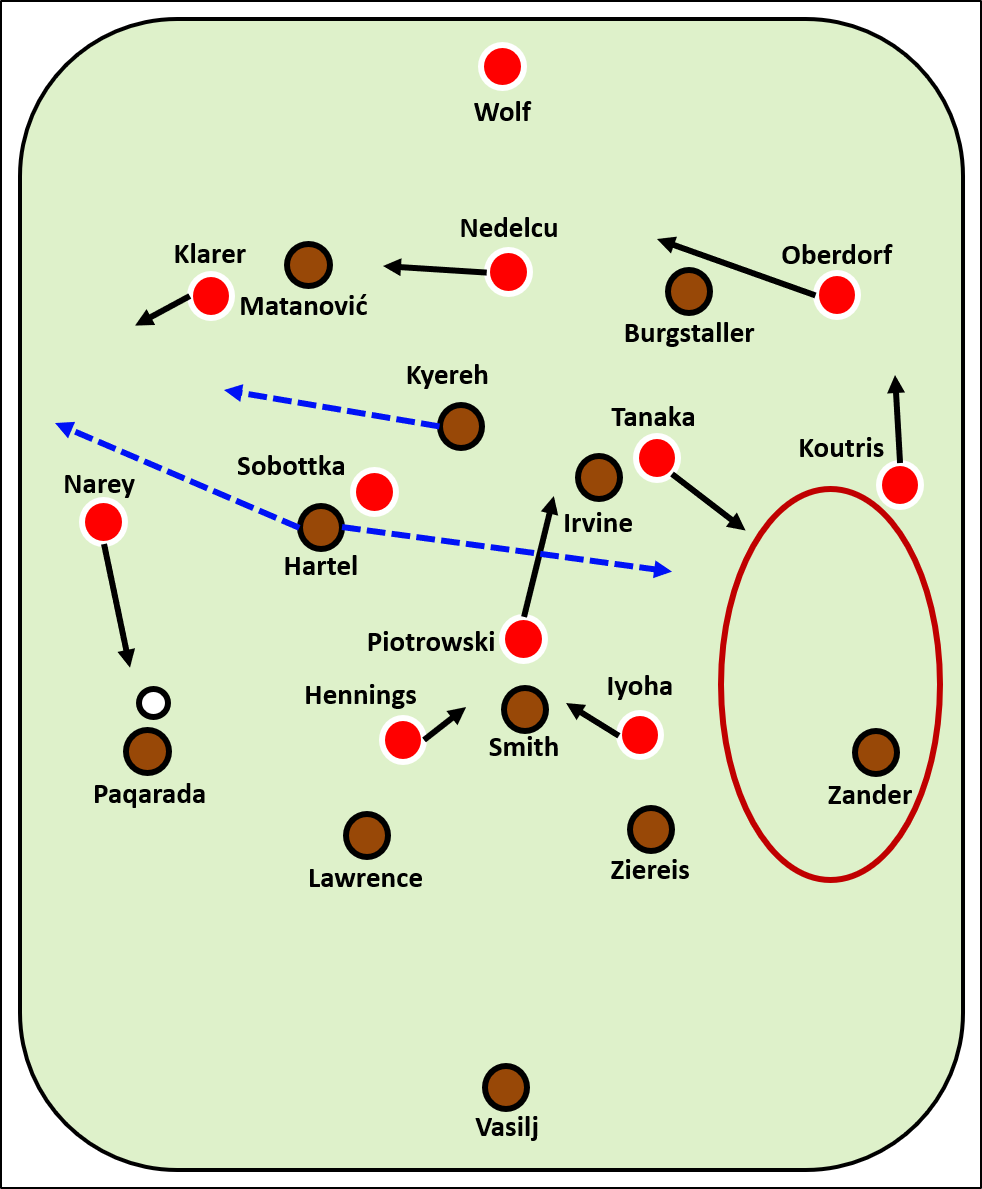
Mehr Mut, mehr Gegenpressing
Was in der ersten Halbzeit noch selten, aber in der zweiten Halbzeit immer häufiger beobachtet werden konnte, waren nicht die Bewegungen von Hartel auf die rechte Seite, sondern ganz nach links. Im Rücken von Narey, den Paqarada oft klug nach innen mitzog, konnte Hartel, ganz nah an der Seitenlinie positioniert, mehrfach aufdrehen. Da auch Kofi Kyereh sich nun viel häufiger auf diese Seite zwischen den beiden Viererketten bewegte, konnte im dortigen Raum immer wieder eine Überzahl gebildet werden. Das war durchaus mutig dort in den engen Raum hinein zu spielen, aber es hat sich ein ums andere Mal gelohnt.
Doch nicht nur das Positionsspiel im Aufbau verbesserte sich mit Wiederanpfiff: Der FCSP zeigte sich enorm giftig im Gegenpressing. So entstand dann auch die Führung kurz nach der Halbzeit, als Smith, mal wieder, erfolgreich den Ball eroberte (mit der Hacke!) und Kyereh in der Folge butterweich in den Rücken von Narey flanken konnte. Die Führung war verdient. Und endlich war es Marcel Hartel. Der hat sich dieses Tor mit einer richtig guten (Lauf-)Leistung auch verdient.
Das Spiel des FC St. Pauli wurde eigentlich mit jeder Minute besser und griffiger. Lawrence und Ziereis nutzten nun noch häufiger als in der ersten Halbzeit die sich ihnen bietenden Räume und dribbelten vermehrt nach vorne (insgesamt taten sie es siebenmal – durchschnittlich machen das Innenverteidiger von Zweitligateams zusammen 1.3mal pro Spiel). Beide Innenverteidiger zeigten zudem einmal mehr eine defensiv sehr stabile Leistung. Es war offensiv aber vor allem das Trio Hartel/Kyereh/Paqarada, welches nun richtig aufdrehte und Fortuna Düsseldorf vor viele Probleme stellte.
Eine eigentlich fatale Reaktion
Auf die nun verstärkte Überladung der linken Seite reagierte F95-Trainer Christian Preußer mit einer Umstellung der Formation nach rund einer Stunde. Er versuchte die Seiten personell zu stärken (Timo Schultz hatte auf der PK vor dem Spiel beschrieben, dass im 3-5-2 die Außenbahnen nur einzeln besetzt sind und sich genau dort Probleme ergeben können). Nach meinem Empfinden machte er es damit aber nur noch schlimmer. Denn mit der Einwechslung von Kristoffer Peterson für Nedelcu stellte Fortuna auf ein 4-1-4-1 um. Peterson agierte nun auf links und Iyoha ließ sich aus der Stürmer-Position ins rechte Mittelfeld fallen. Das 4-1-4-1 ist aber so ziemlich die schlechteste Formation, die man gegen den FC St. Pauli wählen kann, wie zuletzt das Spiel gegen Sandhausen zeigte (hier der Spielbericht).
In der Folge wurde Fortuna Düsseldorf enorm tief in die eigene Hälfte gedrängt und konnte überhaupt keinen Zugriff mehr generieren. Eines der Kernprobleme des 4-1-4-1 gegen den FCSP ist die Unterzahl ganz vorne: Rouwen Hennings verkam in dieser Phase zum Spielball der defensiven Zentrale des FC St. Pauli, da er alleine gegen drei agieren musste. Zudem konnten sich die Achter und auch Kyereh besser zwischen den Ketten bewegen. Durch die Bewegungen der Achter hatten auch die Außenverteidiger mehr Zeit und Raum im Aufbauspiel, da ihre direkten Gegenspieler leichter in der Kette gebunden werden konnten. Alles in allem war das eigentlich eine ziemlich fatale Umstellung, die Fortuna Düsseldorf da vollzog. Ab der 75. Minute stellte Düsseldorf dann das Pressingverhalten um und lief bis zum Ende enorm hoch an, um überhaupt irgendeine Art von Zugriff zu generieren. Die weiten Räume dahinter konnte der FC St. Pauli zwar nutzen, aber nicht so zwingend, wie es zu erwarten war.
(Nachdem ich sah, dass Fortuna auf ein 4-1-4-1 umgestellt hatte, hielt ich es nur für eine Frage der Zeit, bis Finn Ole Becker eingewechselt werden würde, da er sich zwischen den Ketten sehr gut bewegt. Keine Ahnung, warum das nicht passiert ist – auf der anderen Seite führte Jackson Irvine die meisten Defensivzweikämpfe und gewann dabei auch noch gut zwei Drittel.)
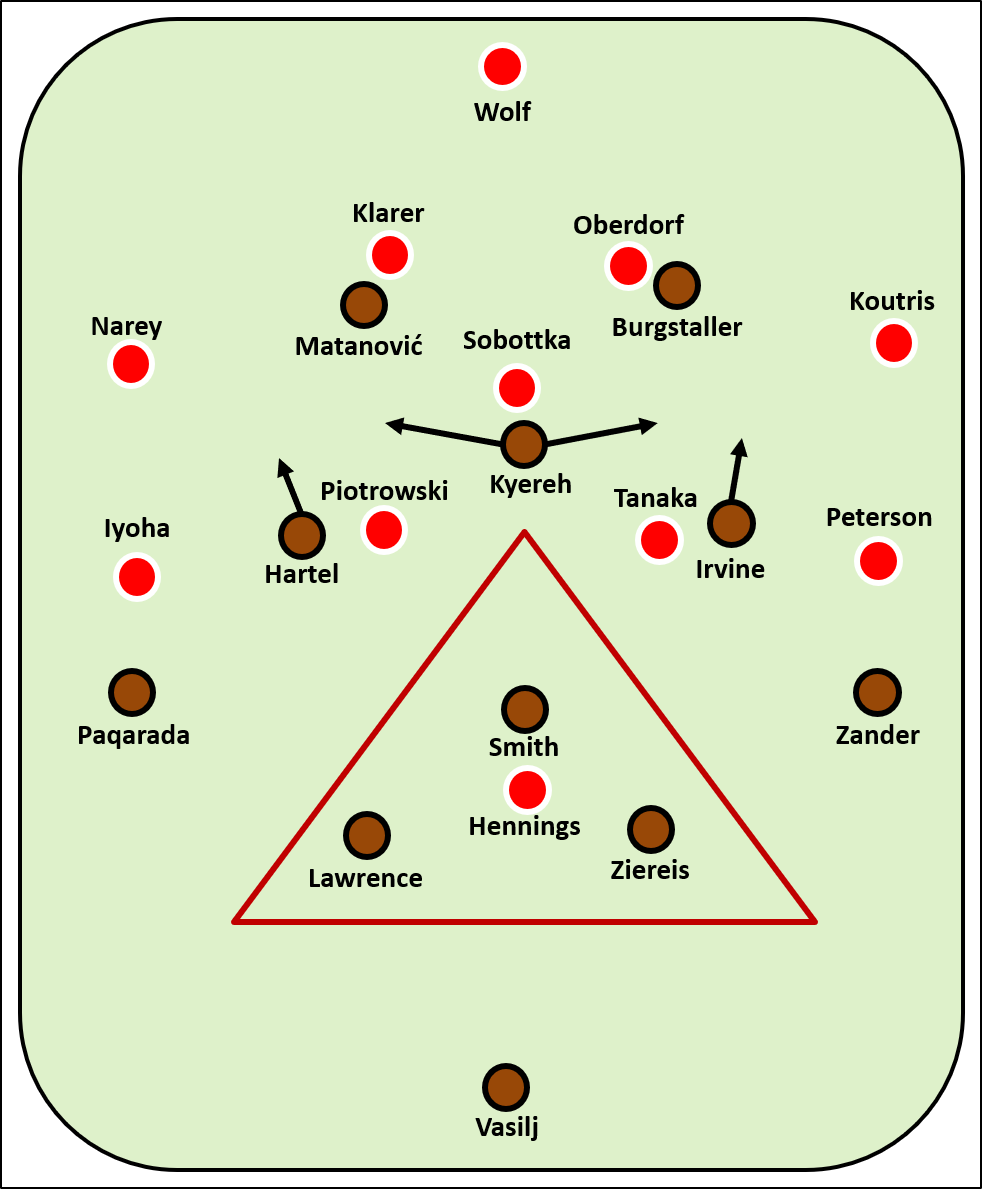
Ich habe auch keine Ahnung, wie es in der absolut stärksten Phase des FC St. Pauli passieren konnte, dass Fortuna Düsseldorf ausglich. Ein Gegentor aus der Kategorie „vermeidbar“ ist es in jedem Fall gewesen. Ein ziemlich guter Angriff der Fortuna allerdings auch.
Der FC St. Pauli blieb danach aber weiterhin das spielbestimmende Team. Erst als Fortuna dann höher anlief, wurde das Spiel unruhiger und die starke Dominanz des FCSP nahm ab. Chancen auf das Siegtor hatten dann noch beide Teams.
Das Unentschieden geht dann in der Summe aber schon in Ordnung, wenngleich ich den FC St. Pauli eher zum Punktsieger erklären würde. Fortuna Düsseldorf ging mit einem guten Konzept in die Partie und konnte dem FC St. Pauli zu Spielbeginn schon deutlich den Zahn ziehen. Möglich, dass wir diese Art der Manndeckung eines Außenverteidigers diese Saison noch häufiger sehen werden. Das Spiel des FC St. Pauli ist aufgrund der enormen Stärke im Spielaufbau von Paqarada einfach sehr linkslastig. Das wurde von Düsseldorf eiskalt und ziemlich pragmatisch gelöst. Mut macht aber, dass es dem FC St. Pauli mit zunehmender Spieldauer trotzdem gelang das dominante Team zu werden und verdient in Führung zu gehen.
Mit der Umstellung auf ein 4-1-4-1 machte sich Fortuna Düsseldorf das eigentlich gute Spiel fast selbst komplett zunichte. Preußer wird gute Gründe für die Umstellung gehabt haben. Der Spielverlauf hat aber gezeigt, dass diese Umstellung eher dem FCSP in die Karten spielte, als Düsseldorf mehr Stabilität zu verleihen.
So darf man sich beim FC St. Pauli schon ein wenig ärgern. Da war nämlich durchaus mehr drin als diese Punkteteilung (xG: 1.5 – 0.9 pro FCSP). Klar, vor der Saison und evtl. auch vor dem Spiel wäre ich mit einem Punkt in Düsseldorf zufrieden gewesen. Basierend auf dem Spielverlauf hätten es dann aber auch gerne deren drei sein können. Ich ärgere mich da ziemlich drüber. Andererseits freue ich mich sehr, dass der FC St. Pauli immer wieder Antworten auf schwierige Spielsituationen findet. Dieses Spiel ist daher sicher nicht nur aufgrund des einen Punktes für die weitere Saison besonders wertvoll.
Mit dem Punkt in Düsseldorf beendet der FC St. Pauli die Hinrunde mit sagenhaften 36 Punkten. An der ein oder anderen Stelle wäre sicher mehr drin gewesen, aber es gab auch Spiele, die eher glücklich für sich entschieden werden konnten (Hallo Nürnberg!). Lange drüber nachdenken kann der Herbstmeister aber nicht, da direkt am Freitag die Rückrunde mit dem Auswärtsspiel in Kiel startet. Ich hoffe sehr, dass wir diese Rückrunde mit drei Punkten gegen Fortuna Düsseldorf am Millerntor beenden und wir danach ordentlich was zu feiern haben (und die Pandemie es zulässt, dass wir das auch tun können). Wir sind da jetzt so weit gekommen, haben nun gegen alle Teams gespielt und sehen können, dass sich da eine richtig gute und richtig stabile Truppe entwickelt hat. Natürlich ist es noch ein weiter Weg, aber, verdammt nochmal, so groß wie diese Saison waren unsere Chancen auf einen Aufstieg lange nicht mehr! Nicht nachlassen jetzt!
Immer weiter vor!
// Tim
Alle Beiträge beim MillernTon sind gratis. Wir freuen uns aber sehr, wenn Du uns unterstützt.
MillernTon auf BlueSky // Mastodon // Facebook // Instagram // Threads // WhatsApp // YouTube
{:}{:en}FC St. Pauli earn a point in Düsseldorf. In this match, first Düsseldorf responded well to FC St. Pauli and later FC St. Pauli responded well to Fortuna Düsseldorf. After a tough first half, the team in brown and white played excellent football and deservedly took the lead. However, Düsseldorf equalised in the middle of FCSP’s most substantial period of pressure. After the game became more and more open at the end, it is probably a fair division of points. A sober analysis.
(Cover picture: Peter Böhmer)
The line-up
There were no changes at FC St. Pauli compared to the successful home match against Schalke. I had expected Finn Ole Becker to start and speculated whether Jakov Medić could replace one of the two centre-backs. Neither was the case; the coaching team around Timo Schultz trusted the regular formation of the last match.
But I had also expected a completely different defensive style of play from Düsseldorf. Christian Preußer’steam made only one change compared to the victorious match against Darmstadt: Dragoș Nedelcu replaced the injured Adam Bodzek. He moved to the central centre-back position, Christoph Klarer played on the right side. As expected, Fortuna Düsseldorf started in a 3-5-2, or did they?

A line of five that is rarely one
In the pre-match report, I had described how Fortuna Düsseldorf would go into pressing in their 3-5-2. I had suspected that this type of pressing does not suit FC St. Pauli at all, as they either give the FCSP wing-backs too much time in the build-up to the game, or the FCSP attackers can create spaces for themselves in the back of the wing-backs. Therefore, I had suspected that this would lead to massive problems for Fortuna Düsseldorf. I should conjecture more cautiously because it turned out differently. Because Fortuna Düsseldorf played the 3-5-2 with an already quite clear imbalance:
Khaled Narey, Fortuna’s right wing-back, permanently moved very close to Leart Paqarada when FC St. Pauli had possession. As a result, Paqarada had little time to process and pass the ball or was not even played at all. It is a rather untypical style of play for opponents to guard the full-backs so closely. However, this approach proved to be exactly right at the start of the game. FC St. Pauli did not find their way to their dreaded build-up play.
Narey’s high positioning shifted Düsseldorf’s entire positioning: Leonardo Koutris, Narey’s counterpart on the left, interpreted his role much more defensively and always dropped back into the last chain when FCSP had possession of the ball. This allowed the back three to move completely one position to the right, turning the nominal 3-5-2 into a 4-4-2, as there were also four players on a line in front of the back four, as Jakub Piotrowski dropped from his attacking position between the Tanaka/Sobottka double six.
Nevertheless, I would still describe Fortuna Düsseldorf’s formation as a 3-5-2, as this 4-4-2 only ever formed when Leart Paqarada was near the ball, i.e. when the ball was on FC St. Pauli’s left. However, when the ball moved to the right, Fortuna Düsseldorf did not mirror this behaviour but formed a straightforward 3-5-2.
FC St. Pauli had problems with this formation. Because it picked up a lot of what worked well for Braun-Weiß in the last games and disrupted these routines, this partial 4-4-2 of Düsseldorf also allowed the broad position of the FCSP forwards to fizzle out. Against Schalke, this was precisely something of a sticking point: FCSP managed to get behind the wing defenders by moving both strikers outwards so that the Schalke three-person backline had to pull enormously vast and thus opened up spaces (explained in more detail here). Against Düsseldorf, Matanović and Burgstaller also tried these movements at the beginning. But because Fortuna stood at the back with a four-person defence, they could absorb these movements of the FCSP strikers without any problems. A first point victory for Düsseldorf. They did that very well.

(c) Peter Böhmer
FC St. Pauli, on the other hand, looked for solutions for large parts of the first half. The longer the game lasted, the more often they were found. Towards the end of the first half, the team looked for more and more build-ups on the right side, as the opponent’s pressure did not come directly from the wing defender, but Ao Tanaka from midfield ran into Luca Zander when he had the ball. However, the build-up play on the right did not really work. It was noticeable that Zander had to accept the much more prominent role as initiator of his attacks. In addition, Jackson Irvine always interprets his role on the half position more offensively than Marcel Hartel on the other side, so that there were not necessarily many play-off stations for Zander. Zander, therefore, had a relatively large amount of space, but he was rarely able to use it, especially at the start of the game, as the shifts to his side were usually played very sluggishly.
In the course of the first half, Marcel Hartel then moved to the right side again and again and thus created a surplus in the half-space. In addition, James Lawrence used the space available to him several times, as with Hennings and Iyoha, there were only two players against Smith, Ziereis and Lawrence (the attacker on the far side of the ball acted in a man-oriented manner on Smith – so with a quick shift, the centre-backs had space to dribble). Also, thanks to these movements, FC St. Pauli was able to gain more and more control of the game and were clearly the better team by the end of the first half.

More courage, more counter-pressing
What could still be observed rarely in the first half but more and more frequently in the second half were not Hartel’s movements to the right side but all the way to the left. At the back of Narey, whom Paqarada often cleverly pulled inside, Hartel, positioned very close to the touchline, was able to turn up several times. With Kofi Kyereh now also moving much more frequently to that side between the two back four, it was always possible to create a superior number in the space there. It was pretty brave to play into the tight space there, but it paid off time and time again.
But it was not only the positional play in the build-up that improved after the restart: FCSP showed itself enormously poisonous in counter-pressing. That’s how the lead came about shortly after half-time when Smith, once again, successfully won the ball (with his heel!), and Kyereh was then able to cross butter-softly into the back of Narey. The lead was deserved. And finally, it was Marcel Hartel. He earned this goal with an excellent (running) performance.
FC St. Pauli’s play actually got better and more gripping with every minute. Lawrence and Ziereis used the available space more often than in the first half and dribbled forward more often (in total, they did it seven times – on average, centre-backs of second division teams do it 1.3 times per match). Both centre-backs once again showed a defensively very stable performance. But mainly, the trio Hartel/Kyereh/Paqarada really turned up the heat and caused Fortuna Düsseldorf many problems.
An actually fatal reaction
F95 coach Christian Preußer reacted to the increased overloading of the left side with a change of formation after about an hour. He tried to strengthen the sides (Timo Schultz had described in the pre-match briefing that in a 3-5-2, the outer lanes are only occupied individually and where problems can arise). In my opinion, however, he only made things worse. With the substitution of Kristoffer Peterson for Nedelcu, Fortuna switched to a 4-1-4-1. Peterson now played on the left, and Iyoha dropped from the striker position to the right midfield. However, the 4-1-4-1 is pretty much the worst formation you can choose against FC St. Pauli, as the game against Sandhausen recently showed (here is the match report).
As a result, Fortuna Düsseldorf was forced deep into their half and could no longer generate access. One of the core problems of the 4-1-4-1 against FCSP is the lack of space upfront: Rouwen Hennings became the plaything of the FC St. Pauli defensive centre in this phase, as he had to act alone against three. In addition, the eights and also Kyereh were able to move better between the chains. The movements of the eights also gave the full-backs more time and space in the build-up play, as their direct opponents could be tied up in the chain more efficiently. All in all, this was actually a fatal change that Fortuna Düsseldorf made. From the 75th minute onwards, Düsseldorf changed their pressing behaviour and ran enormously high until the end to generate any access at all. FC St. Pauli used the wide spaces behind them, but not as compellingly as expected.
(After seeing that Fortuna had switched to a 4-1-4-1, I thought it was only a matter of time before Finn Ole Becker would be substituted, as he moves very well between the chains. I don’t know why that didn’t happen – on the other hand, Jackson Irvine led most of the defensive duels and won a good two-thirds of them).

I also have no idea how it could happen that Fortuna Düsseldorf equalised during FC St. Pauli’s most vital phase. In any case, it was a goal from the „avoidable“ category. But it was also a pretty good attack by Fortuna.
FC St. Pauli continued to dominate the game. When Fortuna started to play higher, the game became more restless, and FCSP’s strong dominance diminished. Both teams had chances to score the winning goal.
But the draw is all right, even though I would instead declare FC St. Pauli the winner. Fortuna Düsseldorf went into the match with a good concept and was able to put FC St. Pauli under pressure at the start of the game. We may see this kind of man-to-man defence of a full-back more often this season. The game of FC St. Pauli is simply very lefty-heavy due to Paqarada’s enormous strength in the build-up to the game. Düsseldorf solved this ice-coldly and quite pragmatically. However, it is encouraging that FC St. Pauli nevertheless managed to become the dominant team as the game progressed and deservedly took the lead.
With the change to a 4-1-4-1, Fortuna Düsseldorf almost wholly ruined what was actually a good game. Preußer will have had good reasons for the change. However, the course of the game showed that this change played more into FCSP’s favour than giving Düsseldorf more stability.
So FC St. Pauli can be a little annoyed. More was in it than this division of points (xG: 1.5 – 0.9 per FCSP). Of course, before the season and possibly also before the game, I would have been satisfied with a point in Düsseldorf. But based on how the game went, it could have been three. I’m pretty annoyed about that. On the other hand, I am delighted that FC St. Pauli always finds answers to difficult game situations. Therefore, this game is particularly valuable for the rest of the season, and not just because of the one point.
With the point in Düsseldorf, FC St. Pauli ends the first half of the season with an incredible 36 points. At one point or another, more would certainly have been possible, but there were also games that were decided rather happily in their favour (hello Nuremberg!). But the first of the table after the first leg of the season can’t spend much time thinking about it, because the second half of the season starts on Friday with an away game in Kiel. I really hope that we end this second half of the season with three points against Fortuna Düsseldorf at the Millerntor and that we have something to celebrate afterwards (and that the pandemic allows us to do so). We’ve come so far, we’ve played all the teams and we’ve seen that we’ve developed a really good and really stable squad. Of course, there’s still a long way to go, but, damn it all, our chances of promotion haven’t been this great for a long time! Don’t let up now!
Keep moving forward!
//Tim (translation by Arne)
MillernTon Twitter //
MillernTon YouTube //
MillernTon Facebook //MillernTon Instagram //
If you like what we do here, here you’ll find the information on how to support us.
{:}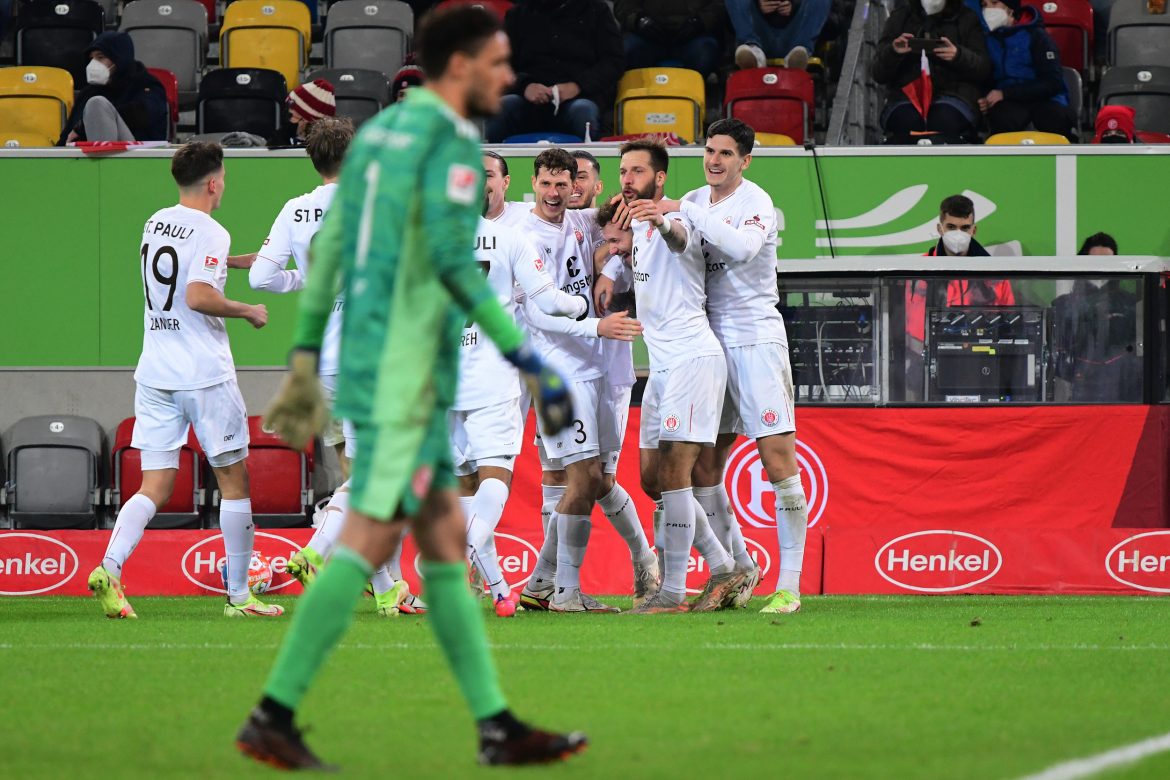

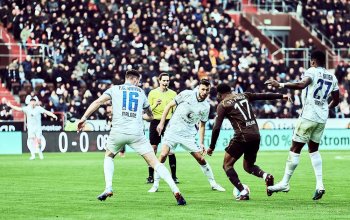

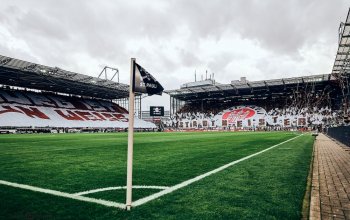
Ich hab mich gewundert, dass smith mit seiner gelben aus der 26. nicht früher ausgewechselt wurde. Dadurch konnte er vor dem Gegentor nicht das Foul ziehen. Hätte hätte Herbstmeister!
Letztendlich: Da wir ja am letzten Spieltag die Fortuna zur Aufstiegsparty zu Gast haben, wollten wir es uns gestern ja nicht mit ihr verderben
Thore,
genau, letztendlich gab es dann gestern Abend in Dusseldorf vielleicht sogar noch eine schöne gemeinsame FanParty, war mein Gedanke nach dem Spiel mit jetzt schon 36 Punkten (gegen den Abstieg). Ich freue mich jetzt schon auf den FortunaBesuch mit anschließender Party am Sonntag den 15. Mai im Neuen Jahr, KickOff um 15:30 Uhr.
Moin Tim,
wie hattest du die späte Einwechslung von Benatelli bewertet? Ich fand diese eher verspätet, da die IV schwer die erste Pressinglinie überwinden konnten und somit kaum Angriffe durch das Zentrum entstanden.
Ein anderes Thema, das mich während des Spiels durch den Kopf ging (und für einen ausführlichen Beitrag möglicherweise interessant wäre), wie könnte die Taktik oder Formation auf solche Gegner, die ein kompaktes 4-4-2 spielen oder allgemein sehr tief stehen, angepasst, mehr Torchancen zu kreieren. Gestern hätte ich zB ein 4-2-2-2 interessant gefunden.
Für mich 2 grösstenteils leichtfertig verschenkte Punkte, die am Ende noch richtig weh tun können! Auffällig, das Burgi und Matanovic aber mal so gar nicht funktionieren, bestes Beispiel hierfür der Bock gegen Schalke, wo Igor selber schiessen muss, aber zum im Abseits stehenden Burgstaller passt…Warum Burgi allerdings gestern sich dann fast komplett ins Mittelfeld zurückzieht, erschloss sich mir auch nicht wirklich…Und Kyereh, abgesehen vom Klasse-Pass auf Hartel, spielt seit Wochen für mich so, als wenn er irgendwie mit dem Kopf schon beim Afrika-Cup, oder, even worse, bei nem anderen Verein ist. Kopf nicht Oben, spielt einfach nicht den besser postierten Mann an , dribbelt sich fest und schiesst aus 8 Metern völlig freistehend dem Keeper den Ball genau in die Arme. Yo, schon klar, jammern auf hohem Niveau, aber wir müssen einfach Alles dafür tun, diese Riesenchance auf den Aufstieg wahrzunehmen, denn die wird wohl nicht so schnell wiederkommen, und gestern haben wir wieder mal auswärts eben nicht wirklich Alles getan…
Danke Tim.
*Left Wing Football Club*, ha.
Forza.
Moin, ja es war mehr drin. Hätten auch mehr Druck machen müssen, denn dann lief es auch. Dennoch, 36 Punkte und 1.mehr kann man nicht verlangen. Erst mal dran bleiben und hoffen, daß es keinen Einbruch gibt. Am Ende wird sich zeigen ob es reicht. Wenn nicht, dann zumindest vor den rothosen.